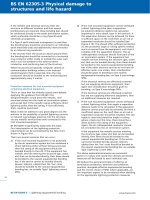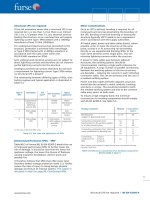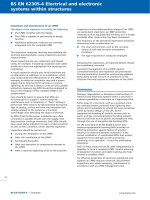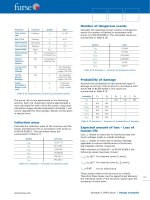Bsi bs en 00717 2 1995 (2002)
Bạn đang xem bản rút gọn của tài liệu. Xem và tải ngay bản đầy đủ của tài liệu tại đây (220.21 KB, 16 trang )
BRITISH STANDARD
BS EN
717-2:1995
Incorporating
Corrigendum No. 1
Wood-based panels —
Determination of
formaldehyde
release —
Part 2: Formaldehyde release by the gas
analysis method
ICS 79.060.20
BS EN 717-2:1995
Cooperating organizations
The European Committee for Standardization (CEN), under whose supervision
this European Standard was prepared, comprises the national standards
organizations of the following countries:
Austria
Belgium
Denmark
Finland
France
Germany
Greece
Iceland
Ireland
Italy
Luxembourg
Netherlands
Norway
Portugal
Spain
Sweden
Switzerland
United Kingdom
This British Standard, having
been prepared under the
direction of the Technical Sector
Board for Building and Civil
Engineering, was published
under the authority of the
Standards Board and comes
into effect on 15 March 1995
© BSI 9 December 2002
Amendments issued since publication
Amd. No.
Date
Comments
14072
9 December 2002
Change to 7.4
Corrigendum No. 1
The following BSI references
relate to the work on this
standard:
Committee reference B/541
Draft for comment 92/13657 DC
ISBN 0 580 23101 1
Oesterreichisches Normungsinstitut
Institut belge de normalisation
Dansk Standard
Suomen Standardisoimisliito, r.y.
Association franỗaise de normalisation
Deutsches Institut fỹr Normung e.V.
Hellenic Organization for Standardization
Technological Institute of Iceland
National Standards Authority of Ireland
Ente Nazionale Italiano di Unificazione
Inspection du Travail et des Mines
Nederlands Normalisatie-instituut
Norges Standardiseringsforbund
Instituto Portugs da Qualidade
Asociación Espola de Normalización y Certificación
Standardiseringskommissionen i Sverige
Association suisse de normalisation
British Standards Institution
BS EN 717-2:1995
Contents
Cooperating organizations
National foreword
Foreword
Text of EN 717-2
National annex NA (informative) Committees responsible
© BSI 9 December 2002
Page
Inside front cover
ii
2
3
11
i
BS EN 717-2:1995
National foreword
This British Standard has been prepared under the direction of the Technical
Sector Board for Building and Civil Engineering and is the English language
version of EN 717-2:1994, Wood-based panels — Determination of formaldehyde
release — Part 2: Formaldehyde release by the gas analysis method, including
corrigendum July 2002, published by the European Committee for
Standardization (CEN).
EN 717-2 was published as a result of international discussion in which the UK
took an active part.
It is one of a series of standards specifying methods for determining formaldehyde
release from wood-based panels. The other standards of this series are:
EN 120 Wood-based panels — Determination of formaldehyde content —
Extraction method called the perforator method.
EN 717 Wood-based panels — Determination of formaldehyde release —
Part 1: Walk-in-chamber reference method.
EN 717-3 Wood-based panels — Determination of formaldehyde release —
Part 3: Formaldehyde release by the flask method.
There is no equivalent text to EN 717-2 in the British Standard for particleboard
(BS 5669) or in the British Standard for fibreboards (BS 1142).
Cross-references
The British Standards which implement international or European publications
referred to in this document may be found in the BSI Catalogue under the section
entitled “International Correspondence Index”, or by using the “Search” facility
of the BSI Electronic Catalogue or of British Standards Online.
This publication does not purport to include all the necessary provisions of a
contract. Users are responsible for its correct application.
Compliance with a British Standard does not of itself confer immunity
from legal obligations.
Summary of pages
This document comprises a front cover, an inside front cover, pages i and ii,
the EN title page, pages 2 to 11 and a back cover.
The BSI copyright date displayed in this document indicates when the document
was last issued.
ii
© BSI 9 December 2002
EUROPEAN STANDARD
EN 717-2
NORME EUROPÉENNE
EUROPÄISCHE NORM
November 1994
ICS 79.060.20
Incorporating corrigendum July 2002
Descriptors: Wood products, wooden boards, determination, release, formaldehyde, analysis methods, gas analysis
English version
Wood-based panels — Determination of
formaldehyde release —
Part 2: Formaldehyde release by the gas analysis method
Panneaux à base de bois —
Détermination du dégagement de formaldéhyde —
Partie 2: Dégagement de formaldéhyde par la
méthode d’analyse de gas
Holzwerkstoff —
Bestimmung der Formaldehydabgabe —
Teil 2: Formaldehydabgabe nach der
Gasanalyse-Methode
This European Standard was approved by CEN on 1994-11-24. CEN members
are bound to comply with the CEN/CENELEC Internal Regulations which
stipulate the conditions for giving this European Standard the status of a
national standard without any alteration.
Up-to-date lists and bibliographical references concerning such national
standards may be obtained on application to the Central Secretariat or to any
CEN member.
This European Standard exists in three official versions (English, French,
German). A version in any other language made by translation under the
responsibility of a CEN member into its own language and notified to the
Central Secretariat has the same status as the official versions.
CEN members are the national standards bodies of Austria, Belgium, Denmark,
Finland, France, Germany, Greece, Iceland, Ireland, Italy, Luxembourg,
Netherlands, Norway, Portugal, Spain, Sweden, Switzerland and
United Kingdom.
CEN
European Committee for Standardization
Comité Européen de Normalisation
Europäisches Komitee für Normung
Central Secretariat: rue de Stassart 36, B-1050 Brussels
© CEN 1994 Copyright reserved to CEN members
Ref. No. EN 717-2:1994 E
EN 717-2:1994
Foreword
This European Standard has been prepared by
Technical Committee CEN/TC 112, Wood-based
panels, the secretariat of which is held by DIN.
This European Standard shall be given the status of
a national standard, either by publication of an
identical text or by endorsement, at the latest by
May 1995, and conflicting national standards shall
be withdrawn at the latest by May 1995.
The gas analysis method was developed
during 1965 to 1973 by the European Federation of
Associations of Particleboard Manufacturers
FESYP. A summary appeared in 1969 under the
title FESYP Perforator Method, FESYP Gas
Analysis Method as Special Booklet 1/1969 of
FESYP.
During the subsequent years this procedure was
modified and improved in certain respects by the
Wilhelm-Klauditz-Institut, Fraunhofer Working
Group for Wood Research (WKI), Braunschweig. In
September 1984 the gas analysis method became a
German standard (DIN 52 368).
Contents
Foreword
1
Scope
2
Normative references
3
Principle
4
Reagents
5
Apparatus
6
Test pieces
7
Procedure
8
Expression of results
9
Test report
Figure 1 — Gas analysis test apparatus
Figure 2 — Example of a calibration
curve for formaldehyde determined by
acetylacetone method (path length 50 mm)
Page
2
3
3
3
3
3
6
6
8
10
5
9
This standard is one of a series which specifies
methods for determining formaldehyde potential in
or formaldehyde release from wood-based panels.
The other standards of this series are:
EN 120 Wood-based panels — Determination of
formaldehyde content — Extraction method called
the perforator method.
EN 717-1 Wood-based panels — Determination of
formaldehyde release — Part 1: Walk-in-chamber
reference method.
EN 717-3 Wood-based panels — Determination of
formaldehyde release — Part 3: Formaldehyde
release by the flask method1).
In accordance with the Common CEN/CENELEC
Rules the following countries are bound to
implement this European Standard: Austria,
Belgium, Denmark, Finland, France, Germany,
Greece, Iceland, Ireland, Italy, Luxembourg,
Netherlands, Norway, Portugal, Spain, Sweden,
Switzerland and the United Kingdom
1)
2
At present at the draft stage.
© BSI 9 December 2002
EN 717-2:1994
1 Scope
This European Standard describes a procedure for determination of accelerated formaldehyde release from
wood-based panels.
2 Normative references
This European Standard incorporates by dated or undated reference, provisions from other publications.
These normative references are cited at the appropriate places in the text and the publications are listed
hereafter. For dated references, subsequent amendments to or revisions of any of these publications apply
to this European Standard, only when incorporated in it by amendment or revision. For undated references
the latest edition of the publication referred to applies.
EN 322 Wood-based panels — Determination of moisture content.
EN 326-1 Wood-based panels — Sampling, cutting and inspection — Part 1: Sampling and cutting of test
pieces and expression of test results.
3 Principle
A test piece of known surface area is placed in a closed chamber in which the temperature, humidity,
airflow and pressure are controlled to defined values. Formaldehyde released from the test piece mixes
with the air in the chamber. This air is continually drawn from the chamber and passes through gas wash
bottles, containing water, which absorbs the released formaldehyde. At the end of the test, the
formaldehyde concentration is determined photometrically. The formaldehyde release is calculated from
this concentration, the sampling time and the exposed area of the test piece and is expressed in milligrams
per square meter and per hour (mg/m2h).
4 Reagents
4.1 General
Reagents of recognized analytical purity and distilled or demineralized water (referred throughout the
following text as distilled water) shall be used for the analysis.
4.2 Acetylacetone solution
4 ml acetylacetone are added to a 1 000 ml volumetric flask and made up to the mark with distilled water.
4.3 Ammonium acetate solution
200 g ammonium acetate are dissolved with distilled water in a 1 000 ml volumetric flask and made up to
the mark.
NOTE
Commercially prepared solutions may be used, provided it can be shown that they give an equivalent result.
5 Apparatus
5.1 The test apparatus (See Figure 1) comprises the following main components:
5.1.1 Air filter (1)
5.1.2 Wash bottle, 500 ml, containing ca. 400 ml distilled water (2).
5.1.3 Desiccator, 500 ml, containing silica gel (3).
5.1.4 Air pump (4).
5.1.5 Needle value (5).
5.1.6 Equipment for measuring rate of air flow through apparatus (6).
5.1.7 Test chamber (length: 555 mm, diameter: 96 mm, internal volume: 4 017 ml) with double casing of
stainless steel or glass (7).
5.1.8 Heating equipment of air (e.g. copper coil inside the double casing) (8).
© BSI 9 December 2002
3
EN 717-2:1994
5.1.9 Thermostat (9).
5.1.10 Magnetic valves (10).
5.1.11 Four pairs of wash bottles, 100 ml (21).
5.1.12 Pressure monitor (22).
5.1.13 Temperature monitor (23).
5.2 Laboratory equipment
5.2.1 Ventilated oven, as described in EN 322.
5.2.2 Spectrophotometer with cells of 50 mm optical path length and capable of measuring absorbance
at 412 mm.
5.2.3 Water bath, capable of maintaining a temperature of (40 ± 1) °C.
5.2.4 Six volumetric flasks, 100 ml (calibrated at 20 °C).
5.2.5 Four volumetric flasks, 250 ml (calibrated at 20 °C).
5.2.6 Two volumetric flasks, 1 000 ml (calibrated at 20 °C).
5.2.7 Eight wash bottles, 100 ml.
5.2.8 Bulb pipettes, 5 ml, 10 ml, 15 ml, 20 ml, 25 ml, 50 ml, 100 ml (calibrated at 20 °C).
5.2.9 Five flasks, 50 ml, (with stoppers).
5.2.10 Microburrette.
5.2.11 Burette, 50 ml, graduated in 0,05 ml (calibrated at 20 °C).
5.2.12 Balance, capable of measuring to 0,001 g.
4
© BSI 9 December 2002
EN 717-2:1994
Figure 1 — Gas analysis test apparatus
© BSI 9 December 2002
5
EN 717-2:1994
6 Test pieces
6.1 Selection of test pieces for production control
Sampling and cutting of the test pieces shall be in accordance with EN 326-1.
Test pieces are taken uniformly distributed over the width of the (cooled) board, but excluding a 500 mm
wide strip at each end of the board as follows:
— for the determination of formaldehyde release, three test pieces of 400 mm × 50 mm × board
thickness;
— for the determination of moisture content, five or six test pieces of 25 mm × 25 mm × board thickness.
All test pieces have to be placed in a hermetically sealed container immediately after cutting and stored at
room temperature.
6.2 Selection of test pieces for other purposes
The procedure of taking test pieces (e.g. from boards already installed) shall be noted and described in the
test report. The number and dimensions of the test pieces shall be as give in 6.1.
6.3 Preparation of test pieces
The test pieces shall be edge sealed.
NOTE
Three coats of polyurethane lacquer or self-adhesive aluminium tape have proved to be suitable.
7 Procedure
7.1 Number of determinations
Determinations shall always be made in duplicate using two different test pieces. If the individual values
of a duplicate determination differ from each other by more than 0,5 mg/m2 h then a third determination
shall be made.
NOTE
For internal inspection a single determination can be sufficient.
7.2 Determination of moisture content
Moisture content shall be determined according to EN 322 using a separate sample (see 6.1).
7.3 Determination of formaldehyde release
Seal the edges of the test pieces in accordance with 6.3.
Close the chamber (5.1.7) and pre-heat it to (60 ± 0,5) °C.
Connect two wash bottles (see 5.1.11), each containing 20 ml to 80 ml distilled water, in series to the outlet
of each magnetic valve (see 5.1.10) using flexible tubing.
Place a test piece in the pre-heated test chamber. After closing the test chamber and starting the test, the
test piece is uniformly exposed to practically formaldehyde free, heated air (60 ± 0,5) °C with a relative
humidity of k3 %. Immediately set the air flow into the chamber to (60 ± 3) l/h, using the needle
valve (5.1.5), and the air volume meter (5.1.6). This air is led into one of a series of pairs of wash bottles via
a magnetic valve (5.1.10).
As the formaldehyde released from the test piece shall be determined at hourly intervals (up to 4 h from
starting the test), a new series of wash bottles has to be connected up every hour. This exchange should be
automatic.
Over the whole test period, the overpressure in the test chamber is monitored (5.1.12). An overpresure
of 1 000 to 1 200 Pa shall be maintained over the entire test period.
Transfer the contents of each pair of wash bottles to a 250 ml volumetric flask (see 5.2.5). Rinse the bottles
and their associated tubing thoroughly and transfer the rinsings to the flask.
NOTE
Care should be taken that the combined contents of the bottles and rinsings does not exceed 250 ml.
Make up the flask to the mark with distilled water and determine the formaldehyde content as specified
in 7.4
6
© BSI 9 December 2002
EN 717-2:1994
7.4 Determination of formaldehyde content of the aqueous solutions
7.4.1 General
The formaldehyde content of the aqueous solution from each 1 h sampling period shall be determined
photometrically.
7.4.2 Principle
The determination is based on the Hantzsch reaction in which aqueous formaldehyde reacts with
ammonium ions and acetylacetone to yield diacetyldihydrolutidine (DDL), DDL has an absorption
maximum at 412 nm. The reaction is highly specific to formaldehyde.
NOTE
Other suitable photometric procedures may also be used.
7.4.3 Procedure
10 ml are taken from the aqueous solution (7.3) with a pipette (5.2.8) and added to 10 ml acetylacetone
solution (4.2) and 10 ml ammonium acetate solution (4.3) in a 50 ml flask (5.2.9). The flask is stoppered,
shaken and warmed for 15 min in a water bath (5.2.3) at 40 °C. The solution is cooled to room temperature
protected against the influence of light (about 1 h). The absorbance of this solution is determined at a
wavelength of 412 nm against distilled water using a spectrophotometer (5.2.2). A blank value is
determined in parallel with distilled water and taken into consideration in the determination of the gas
analysis value.
7.4.4 Calibration curve
The calibration curve is produced from a standard formaldehyde solution, the concentration of which has
been determined by iodometric titration. The calibration curve shall be checked at least once a week.
7.4.4.1 Formaldehyde standard solution reagents:
— standard iodine solution c(I2) = 0,05 mol/1;
— standard sodium thiosulfate solution c(Na2S2O3) 0,1 mol/1;
— standard sodium hydroxide solution c(NaOH) = 1 mol/1;
— standard sulfuric acid solution c(H2SO4) = 1 mol/1;
— starch solution 1 % m/m.
The solutions shall be standardized before use.
About 1 g formaldehyde solution (concentration 35 % to 40 %) is diluted in a 1 000 ml volumetric
flask (5.2.6) with distilled water and made up to the mark. The exact formaldehyde concentration of this
solution is determined as follows:
20 ml of the formaldehyde standard solution is mixed with 25 ml iodine solution and 10 ml sodium
hydroxide solution. After 15 min standing, protected from light, 15, ml of sulfuric acid solution is added.
The surplus iodine is back-titrated with the thiosulfate solution. At the end of the titration some drops of
starch solution are added as an indicator. A blank test with 20 ml distilled water is carried out in parallel.
© BSI 9 December 2002
7
EN 717-2:1994
The formaldehyde content is calculated by the following equation:
c(HCHO) = (Vo – V) × 15 × c(Na2S2O3) × 1 000/20
where
c (HCHO) is the formaldehyde concentration, in milligrams per litre;
c (Na2S2O3) is the thiousulfate concentration in mols per litre;
V
is the volume of thiosulfate titration solution, in millimetres;
Vo
is the volume of thiosulfate titration solution for the blank, in millilitres.
NOTE
(1)
1 ml 0,1 mol/1 thiosulfate solution corresponds to 1 ml 0,05 mol/1 iodine solution and 1,5 mg formaldehyde.
7.4.4.2 Formaldehyde calibration solution
Using the concentration determined in 7.4.4.1, calculate the volume which will contain 3 mg formaldehyde.
Transfer this volume, using a microburette, to a 1 000 ml volumetric flask and make up to the mark with
distilled water. 1 ml of this calibration solution contains 3 Èg formaldehyde.
7.4.4.3 Determination of the calibration curve
Pipette either zero, 5, 10, 20, 50 or 100 ml of formaldehyde calibration solution (7.4.4.2) in a 100 ml
volumeric flask (5.2.4) and make up to the mark with distilled water. 10 ml of each dilution are analysed
photometrically by the same procedure as described above (7.4.3). The absorbance values are plotted
against the formaldehyde concentrations (1) (between 0 and 0,003 mg/ml) on the millimetre graph paper
(see example in Figure 2). The slope (f) is either determined graphically, or calculated.
8 Expression of results
8.1 Gas analysis value
From each 1 h sampling period the gas analysis value Gi is determined and calculated by the following
equation:
(2)
where
Gi
i
AS
AB
f
F
V
8
is the formaldehyde content of the solution from each hourly sample in milligrams divided by the
area of the exposed, unsealed surface;
is the first, second, third or fourth hour;
is the absorbance of the solution from the wash bottles;
is the absorbance of distilled water;
is the slope of the calibration curve for standard formaldehyde solution, in milligrams per
millilitre;
is the combined area of the emitting (unsealed) surfaces, in square metres;
is the volume of the volumetric flask, in millilitres.
© BSI 9 December 2002
EN 717-2:1994
Figure 2 — Example of a calibration curve for formaldehyde determined by acetylacetone
method (path length 50 mm)
© BSI 9 December 2002
9
EN 717-2:1994
8.2 Calculation of results
As a rule the formaldehyde content of the liquid absorbent, taken during the first hour is lower than the
content of the second hour, as the temperature of the test piece over the first hour does not reach 60 °C
immediately. In this case the gas analysis value is calculated from the sum of the contents for hours 2 to 4
and is related to the surface area (F) of the test piece. If the maximum of formaldehyde content is reached
during the first hour, the sum of all four hourly-samples is used for the calculation.
Consequently the average gas analysis value Gm of a test piece is calculated according to the appropriate
equation:
Gm
(3)
Gm
where
Gm is the average gas analysis value of test piece, in milligrams formaldehyde per square metre and
per hour.
The gas analysis value of the board is calculated from the Gm values of the test pieces.
8.3 Moisture content
See EN 322.
9 Test report
The test report shall be issued in accordance with EN 326-1 and shall contain the following additional
information:
a) if appropriate and known, position (e.g. ceiling, floor, wall) and condition (e.g. moisture content,
surface cladding and/or surface quality, fixing) of the board at the time of selection of the test pieces;
b) moisture content of board at the time of testing (see EN 322);
c) gas analysis value of the board together with the individual Gm values in milligrams formaldehyde per
square metre and per hour.
10
© BSI 9 December 2002
BS EN 717-2:1995
National annex NA (informative)
Committees responsible
The United Kingdom participation in the preparation of this European Standard was entrusted by the
Technical Sector Board for Building and Civil Engineering (B/-) to Technical Committee B/541, upon which
the following bodies were represented:
American Plywood Association
Association of British Plywood and Veneer Manufacturers
British Woodworking Federation
Chartered Institute of Building
Coordinator for Timber and Timber Products
Council of the Forest Industries of British Columbia
Department of the Environment (Building Research Establishment)
Finnish Plywood International
Flat Roofing Contractors’ Advisory Board
Forestry Commission
Furniture Industry Research Association
Institution of Structural Engineers
Local Authority Organizations
Municipal Mutual
National Federation of Roofing Contractors
National House-building Council
National Panel Products Association
Royal Institute of British Architects
Structural Board Association
Timber Research and Development Association
Timber Trade Federation
Wood Panel Products Federation
© BSI 9 December 2002
11
BS EN 717-2:1995
BSI — British Standards Institution
BSI is the independent national body responsible for preparing
British Standards. It presents the UK view on standards in Europe and at the
international level. It is incorporated by Royal Charter.
Revisions
British Standards are updated by amendment or revision. Users of
British Standards should make sure that they possess the latest amendments or
editions.
It is the constant aim of BSI to improve the quality of our products and services.
We would be grateful if anyone finding an inaccuracy or ambiguity while using
this British Standard would inform the Secretary of the technical committee
responsible, the identity of which can be found on the inside front cover.
Tel: +44 (0)20 8996 9000. Fax: +44 (0)20 8996 7400.
BSI offers members an individual updating service called PLUS which ensures
that subscribers automatically receive the latest editions of standards.
Buying standards
Orders for all BSI, international and foreign standards publications should be
addressed to Customer Services. Tel: +44 (0)20 8996 9001.
Fax: +44 (0)20 8996 7001. Email: Standards are also
available from the BSI website at .
In response to orders for international standards, it is BSI policy to supply the
BSI implementation of those that have been published as British Standards,
unless otherwise requested.
Information on standards
BSI provides a wide range of information on national, European and
international standards through its Library and its Technical Help to Exporters
Service. Various BSI electronic information services are also available which give
details on all its products and services. Contact the Information Centre.
Tel: +44 (0)20 8996 7111. Fax: +44 (0)20 8996 7048. Email:
Subscribing members of BSI are kept up to date with standards developments
and receive substantial discounts on the purchase price of standards. For details
of these and other benefits contact Membership Administration.
Tel: +44 (0)20 8996 7002. Fax: +44 (0)20 8996 7001.
Email:
Information regarding online access to British Standards via British Standards
Online can be found at />Further information about BSI is available on the BSI website at
.
Copyright
Copyright subsists in all BSI publications. BSI also holds the copyright, in the
UK, of the publications of the international standardization bodies. Except as
permitted under the Copyright, Designs and Patents Act 1988 no extract may be
reproduced, stored in a retrieval system or transmitted in any form or by any
means – electronic, photocopying, recording or otherwise – without prior written
permission from BSI.
BSI
389 Chiswick High Road
London
W4 4AL
This does not preclude the free use, in the course of implementing the standard,
of necessary details such as symbols, and size, type or grade designations. If these
details are to be used for any other purpose than implementation then the prior
written permission of BSI must be obtained.
Details and advice can be obtained from the Copyright & Licensing Manager.
Tel: +44 (0)20 8996 7070. Fax: +44 (0)20 8996 7553.
Email:









